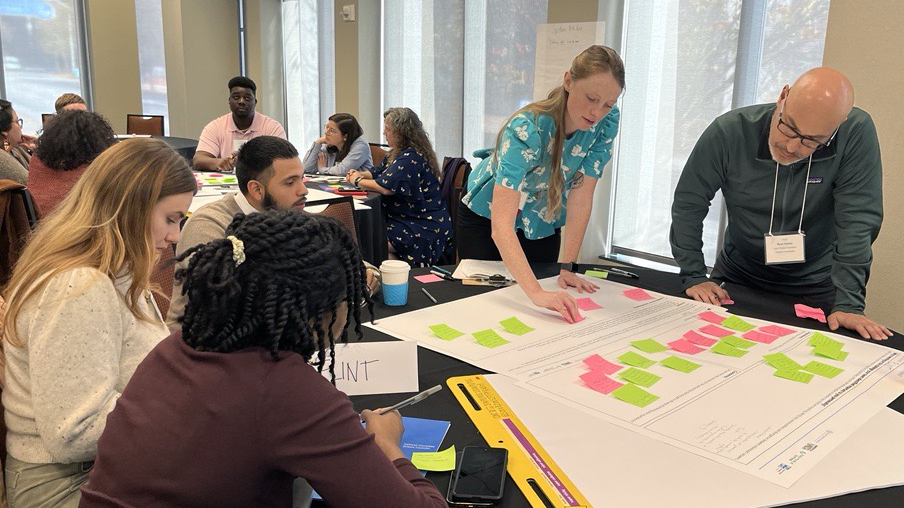All your news. None of the bias.
Be the smartest person in the room by reading 1440! Dive into 1440, where 3.5 million readers find their daily, fact-based news fix. We navigate through 100+ sources to deliver a comprehensive roundup from every corner of the internet – politics, global events, business, and culture, all in a quick, 5-minute newsletter. It's completely free and devoid of bias or political influence, ensuring you get the facts straight.
"In matters of style, swim with the current; in matters of principle, stand like a rock."
-Thomas Jefferson
THE ART OF LEADERSHIP
Adapting Jefferson's Wisdom: Navigating Style and Principle in Leadership
In today's rapidly changing business landscape, the balance between adaptability and steadfastness is more crucial than ever. As Thomas Jefferson famously stated, "In matters of style, swim with the current; in matters of principle, stand like a rock." This guiding principle underscores the importance of being flexible in approach while remaining unwavering in core values.
Flexibility in Style
Adapting to the current trends and evolving practices is essential for any leader. Embracing new technologies, fostering innovative thinking, and staying attuned to market shifts are vital components of successful leadership. This flexibility ensures that organizations remain relevant and competitive in a dynamic environment. Leaders who "swim with the current" are those who can pivot strategies and embrace change without losing sight of their goals.
Unyielding in Principle
While adaptability is necessary, it should never come at the expense of core principles. Integrity, honesty, and ethical behavior are the bedrock of enduring success. In an era where shortcuts and quick fixes are often tempting, standing firm on principles is what distinguishes true leaders. These principles form the foundation of trust and credibility, both internally within the organization and externally with stakeholders.
Balancing Act
The challenge lies in striking the right balance between being adaptable and remaining principled. This requires a deep understanding of when to be flexible and when to hold firm. It involves making decisions that are not only beneficial in the short term but also sustainable in the long term. Leaders must navigate this delicate balance to guide their organizations through uncertain times while maintaining their ethical compass.
Looking Ahead
As we move forward, the dual approach of adaptability and principled leadership will continue to be paramount. Leaders who can master this balance will be well-positioned to drive their organizations toward sustained success. They will be the ones who inspire trust, foster innovation, and create a resilient organizational culture.
By embodying Jefferson's wisdom, leaders can effectively navigate the complexities of modern business, ensuring that they remain relevant and principled in an ever-changing world.
COMMERCIAL CONSTRUCTION
Vacant Office Spaces: A New Frontier for Affordable Housing
Introduction The COVID-19 pandemic has reshaped work habits, leading to a surge in remote work and a spike in vacant office spaces. With office vacancies at historic highs, the adaptive reuse of these buildings for housing presents a promising solution to address both the housing crisis and the economic challenges faced by commercial real estate.
The Opportunity Repurposing office buildings into housing can be cost-effective and environmentally sustainable. The existing structure, elevators, and parking facilities can be reused, significantly reducing construction time and expenses. This approach also helps curb urban sprawl and improve the energy efficiency of older buildings.
Challenges Despite the benefits, several obstacles must be overcome for successful office-to-housing conversions. Financing these projects can be difficult, especially with high interest rates and substantial existing debts. Building layouts, originally designed for office use, often require significant alterations to become suitable for residential purposes. Additionally, local market conditions and regulatory environments can complicate conversions.
Government Initiatives Various state and local governments have introduced incentives to support these conversions. For example, California has allocated $400 million for commercial space conversions, while Wisconsin offers interest-free loans to developers. New York City’s plan aims to create 20,000 new housing units through office-to-residential conversions. These initiatives are complemented by federal support, including low-interest loans and grants, to encourage adaptive reuse projects.
Future Outlook As remote and hybrid work models continue to dominate, the trend of converting vacant office spaces into housing is expected to grow. This innovative solution could play a critical role in addressing the housing shortage and revitalizing urban areas, transforming the landscape of cities across the United States.
Can converting vacant office spaces into affordable housing solve the housing crisis and rejuvenate urban areas?
#AffordableHousing #UrbanRevitalization #AdaptiveReuse— #The Dig Daily Dose (#@TheDigDailyDose)
10:19 AM • Aug 7, 2024
INFRASTRUCTURE INDUSTRY
Connecting Community Infrastructure Projects Through Technical Assistance and Capacity Building
A new initiative aims to bolster community infrastructure projects by offering technical assistance and capacity building, fostering greater connectivity and resilience. This effort, spearheaded by a coalition of organizations, seeks to address the growing need for sustainable infrastructure in underserved communities.
Announcement and Initiative Details
The program, unveiled by the WRI Ross Center for Sustainable Cities, focuses on providing essential support to local governments and organizations. The initiative includes training, technical assistance, and resources to enhance the planning and execution of infrastructure projects. This support is critical in areas where limited resources and expertise hinder progress.
Key Players and Historical Context
WRI Ross Center, known for its work in urban sustainability, leads this initiative in partnership with several key players. This includes local governments, NGOs, and private sector partners. The historical context reveals a persistent gap in infrastructure development in many communities, exacerbated by rapid urbanization and climate change challenges.
Challenges and Positive Aspects
While the initiative promises significant benefits, it also faces challenges such as ensuring equitable distribution of resources and overcoming bureaucratic hurdles. However, the potential positive impact is substantial, with improved infrastructure leading to enhanced quality of life and economic opportunities.
Future Outlook
Looking ahead, the program aims to expand its reach and impact, with plans to include more communities and projects. Continued collaboration and innovation will be essential to overcoming challenges and achieving the goal of sustainable, resilient urban infrastructure. This forward-looking approach ensures ongoing engagement and progress in building better-connected communities.
How will the new initiative by WRI Ross Center address the challenges of equitable resource distribution in community infrastructure projects?
#UrbanDevelopment #Sustainability #ResilientCities— #The Dig Daily Dose (#@TheDigDailyDose)
10:17 AM • Aug 7, 2024
RESIDENTIAL RESEARCH
The Housing Crisis and Its Populist Echoes
Affordable Housing Shortage Spurs Populism
The scarcity of affordable housing has become a pivotal issue, sparking protests across Europe and the U.S. From London to California, soaring property prices have driven young voters toward populist politicians. High rents and housing shortages are fueling disillusionment with democracy and the rise of populism, as leaders like Donald Trump and Nigel Farage link housing woes to increased immigration.
Complex Causes Behind the Crisis
While immigration is often blamed for the housing crunch, experts highlight multiple factors. Inadequate homebuilding, foreign investments, and stringent planning laws contribute to the problem. In the U.S., high interest rates and a construction slowdown have exacerbated the issue, pushing more people into the rental market.
Impact on Democracy and Society
The housing crisis is reshaping political landscapes, with younger generations losing faith in democratic processes. This shift is evident in Europe, where nationalist parties are gaining traction. As populist rhetoric connects housing and immigration, the societal divide deepens, underscoring the urgent need for comprehensive housing policies.
Looking Forward
Governments are under pressure to address the housing shortage. In the U.S., President Biden has proposed measures to increase housing availability, though significant changes require legislative support. The challenge remains: to build enough homes to meet demand and restore faith in democratic systems, ensuring a stable future for the next generation.
How can governments effectively tackle the housing crisis to curb the rise of populism and restore democratic faith?
#HousingCrisis #Populism #Democracy— #The Dig Daily Dose (#@TheDigDailyDose)
10:16 AM • Aug 7, 2024
TOOLBOX TALK
The Importance of Incident Reporting on Construction Sites
Introduction
Good morning, Team! Today, we’re focusing on a crucial aspect of our safety protocols: incident reporting on construction sites. Proper documentation of incidents, including injuries, near-misses, and safety breaches, is essential for preventing future accidents and maintaining a safe work environment. Understanding and implementing effective incident reporting can significantly enhance our safety practices.
Learning from Incidents: The Role of Incident Reporting
Incident reporting helps identify safety hazards, track trends, and develop preventive measures. Accurate and timely reports are crucial for improving safety standards, ensuring compliance with regulations, and fostering a culture of transparency and continuous improvement.
Strategies for Effective Incident Reporting
Clear Procedures: Establish clear, straightforward procedures for reporting incidents. Ensure all workers understand what constitutes an incident and how to report it.
Timely Reporting: Encourage prompt reporting of all incidents, no matter how minor. Quick reporting allows for immediate action and reduces the risk of recurrence.
Detailed Documentation: Include comprehensive details in incident reports, such as the date, time, location, people involved, and a thorough description of the event. Photos and witness statements can provide valuable context.
Regular Training: Conduct regular training sessions to ensure everyone is familiar with the incident reporting process and understands the importance of accurate documentation.
Follow-Up Actions: Use incident reports to identify root causes and implement corrective actions. Regularly review and analyze reports to identify patterns and areas for improvement.
Confidentiality: Maintain confidentiality in reporting processes to encourage openness and honesty without fear of retribution.
Discussion Questions
Have you experienced or witnessed an incident on-site that was not reported? What were the circumstances and outcomes?
What specific practices do you find most effective in ensuring thorough and accurate incident reporting?
How can we improve our current incident reporting protocols to better protect everyone?
Conclusion
Effective incident reporting is vital for enhancing safety and preventing future accidents on construction sites. By establishing clear procedures, encouraging timely and detailed reporting, providing regular training, and ensuring follow-up actions, we can create a safer and more responsive work environment.
Let's commit to prioritizing incident reporting and supporting each other in maintaining high safety standards. Together, we can ensure a safer and more efficient work environment for everyone.








